Round The World and other travels
A frequent flyer's collection of trip diaries
This is: African Contrasts 2015
Princess Salme's Spice Tour
 |
 |
 |
 |
For the third day in a row, we had breakfast at the DoubleTree and then met up with Anjam, our guide from Zanzibar Different, who this morning was sporting a freshly manscaped new look with a close-trimmed goatee replacing his full beard. After picking up the American family from Monday's walking tour at the Tembo House Hotel, we only needed to take a few steps across the beach to begin the first element of today's trip, in which we would be sailing approximately 5km up the coast in a traditional dhow, from Stone Town's attractive seafront to the ruins of Mtoni Palace. As on the previous afternoon, boarding this vessel involved wet feet, but getting safely into the dhow was a good deal more straightforward than the outrigger canoe had been. Making slower progress than expected, we arrived at our objective an hour later.
 |
 |
 |
 |
 |
 |
 Beit el Mtoni literally means 'Palace by
the Stream'. In its day the largest palace on the island, it was the
centre of a community of around 1,000 people, who tended to the
needs of Said bin Sultan and the royal family. Princess Salme, after
whom today's tour was named, was the Sultan's youngest daughter, who
would later elope with a German merchant to live in Hamburg as Emily
Ruete. In the
1880s, Mtoni Palace was abandoned and fell into ruin. Although now in
poor shape, the ruins can still be brought to life by a
knowledgeable guide and can thereby offer visitors a glimpse into
the world of the Arabian royalty who once lived there. We began our
visit in the the former reception hall and progressed into the inner
courtyard, the palace garden and the well preserved bathing complex.
Beit el Mtoni literally means 'Palace by
the Stream'. In its day the largest palace on the island, it was the
centre of a community of around 1,000 people, who tended to the
needs of Said bin Sultan and the royal family. Princess Salme, after
whom today's tour was named, was the Sultan's youngest daughter, who
would later elope with a German merchant to live in Hamburg as Emily
Ruete. In the
1880s, Mtoni Palace was abandoned and fell into ruin. Although now in
poor shape, the ruins can still be brought to life by a
knowledgeable guide and can thereby offer visitors a glimpse into
the world of the Arabian royalty who once lived there. We began our
visit in the the former reception hall and progressed into the inner
courtyard, the palace garden and the well preserved bathing complex.
 |
 |
 |
A 15-minute drive then brought us to Salome’s Garden, an old Omani mansion that is now home to the Zanzibar Creative Education Foundation, where we enjoyed a short rest in the warm sunshine, accompanied by a traditional coffee ceremony.
Due to the time lost earlier in the day on the dhow cruise, the group agreed to skip the next planned stop at the Kidichi Persian Baths, in the interests of getting back on schedule. Accordingly, we pressed on for the final visit of the tour, which was to a mature spice plantation, where we were able to see, learn about, and taste the abundance of spices, fruits and herbal remedies grown in Zanzibar. A spectacular and almost heart-stopping moment occurred when one of the plantation employees climbed a tall and slender coconut palm without any visible safety measures. To round off our visit, we were served a tasty lunch in the open air.
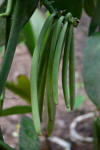 |
 |
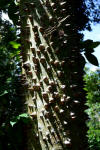 |
 |
 |
LEFT: Some of the plants that we saw during our visit to Mzee Yussuf's spice plantation |
 |
 |
||||
| RIGHT: This impressive and hair-raising feat of agility was performed by one of the plantation employees |
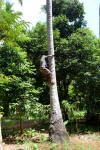 |
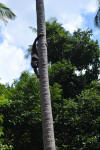 |
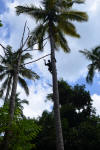 |
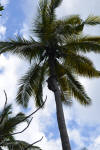 |
 |
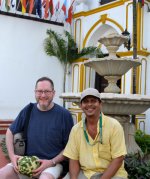 |
| Bruce and Anjam at the end point of the tour |
We had a fairly swift run back to Stone Town, following which it was time to bid farewell to our guide Anjam, with grateful thanks for three wonderfully enjoyable and informative days of sightseeing.
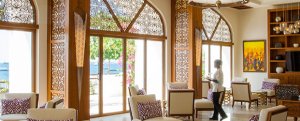 For cocktails and supper,
following an appropriate period of relaxation, we decided to investigate the nearby Park
Hyatt as a possible venue. The hotel's own website spoke of it
as being 'the ultimate haven' for 'discerning business travellers and luxury
holidaymakers', and indeed this seemed to sum the place up very
nicely. It provided comfortable and most agreeable surroundings in
which to celebrate the success of the trip so far, at this more or
less half-way stage.
For cocktails and supper,
following an appropriate period of relaxation, we decided to investigate the nearby Park
Hyatt as a possible venue. The hotel's own website spoke of it
as being 'the ultimate haven' for 'discerning business travellers and luxury
holidaymakers', and indeed this seemed to sum the place up very
nicely. It provided comfortable and most agreeable surroundings in
which to celebrate the success of the trip so far, at this more or
less half-way stage.